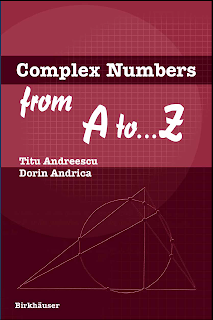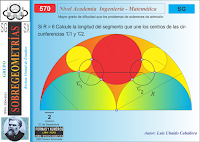quarta-feira, 2 de outubro de 2013
Australian Mathematical Olympiads 1996-2011 Book 2
Not Full version, just enjoy it now
Download Australian Mathematical Olympiads 1996-2011 Book 2
WEBSITE ORIGINAL
http://keoserey.wordpress.com/
terça-feira, 1 de outubro de 2013
Complex Numbers from A to. . . Z Titu Andreescu Dorin Andrica
About the Authors
Titu Andreescu received his BA, MS, and PhD from the West University
of Timisoara, Romania. The topic of his doctoral dissertation was “Research
on Diophantine Analysis and Applications.” Professor Andreescu currently
teaches at the University of Texas at Dallas.
LINK
http://limtaosin.files.wordpress.com/2012/09/26-complexnumbersfromatoz.pdf
Titu Andreescu received his BA, MS, and PhD from the West University
of Timisoara, Romania. The topic of his doctoral dissertation was “Research
on Diophantine Analysis and Applications.” Professor Andreescu currently
teaches at the University of Texas at Dallas.
LINK
http://limtaosin.files.wordpress.com/2012/09/26-complexnumbersfromatoz.pdf
USSR Mathematical Olympiads 1989-1992
SURFANDO EN LA INTERNET ENCONTRE ESTE IMPORTANTE LIBRO PARA ENTRENAMIENTO DE OLIMPIADAS DE MATEMATICAS DE LA CELEBRE ESCUELA RUSA DE MATEMATICAS SON LAS OLIMPIADAS DESDE 1989-1992.
LO PUEDES BAJAR TRANQULAMENTE EN LOS SITIOS WEB QUE ENCONTRE:
http://limtaosin.files.wordpress.com/2012/08/arkadii-m-slinko-ussr-mathematical-olympiads-1989-19921.pdf
http://www.mediafire.com/?91zgkz21zgjuh6w
LO PUEDES BAJAR TRANQULAMENTE EN LOS SITIOS WEB QUE ENCONTRE:
http://limtaosin.files.wordpress.com/2012/08/arkadii-m-slinko-ussr-mathematical-olympiads-1989-19921.pdf
http://www.mediafire.com/?91zgkz21zgjuh6w
18th Chinese Mathematical Olympiad 2003 Problems & Solutions
A1. ABC is an acute-angled triangle with AB and AC unequal, incenter I and orthocenter H. BB1 and CC1 are medians. The line IB1 meets the line AB at B2, and the line IC1 meets the line CA at C2. The line B2C2 meets the line BC at K. The circumcenter of BHC is O'. Show that A, I and O' are collinear iff area BKB2 = area CKC2.
A2. S is a subset of {1,
2, 3, ... , 100} such that given any two elements a, b in S, there is
an element c in S coprime to a and b, and there is an element d in S
which has a common factor with a and a common factor with b. What is
the largest possible number of elements in S?
A3. The reals x1, x2, ... , xn all satisfy 0 < xi < π/2. Also tan x1 tan x2 ... tan xn = 2n/2. Find the smallest L such that cos x1 + cos x2 + ... + cos xn ≤ L for all such xi.
B1. Find all positive integer triples (d, m, n) with d > 1, m> 1 such that dm + 1 divides dn + 203.
B2. There are 10
applicants for a job, labeled 1, 2, ... , 10. Their suitability for the
job is ranked in this order (so 1 is more suitable than 2, who is more
suitable than 3 and so on). But an applicant's ability is only
measured when they are interviewed. They are interviewed in the order a1, a2, ... , a10.
The first three interviewed are automatically rejected. Thereafter if
an applicant's suitability is better than that of all previous
applicants they are accepted (without interviewing the other
applicants). If the first nine applicants interviewed are not accepted,
then the tenth is automatically accepted. Let ni be the number of permutations a1, ... , a10 which result in applicant i getting the job. Show that n1 > n2 > ... > n8 = n9 = n10.
Show that the probability that one of 1, 2, 3 gets the job is over 70%
and that the probability of one of 8, 9, 10 getting the job is not
more than 10%.
B3. a, b, c d are positive reals satisfying ab + cd = 1 and the four points (x1, y1), (x2, y2), (x3, y3), (x4, y4) lie on the circle x2 + y2 = 1. Show that (ay1 + by2 + cy3 + dy4)2 + (ax4 + bx3 + cx2 + dx1)2 ≤ 2(a/b + b/a + c/d + d/c).
Solutions
Problem A1
ABC is an acute-angled triangle with AB and AC unequal, incenter I and orthocenter H. BB1 and CC1 are medians. The line IB1 meets the line AB at B2, and the line IC1 meets the line CA at C2. The line B2C2 meets the line BC at K. The circumcenter of BHC is O'. Show that A, I and O' are collinear iff area BKB2 = area CKC2.
Solution
Thanks to Allen Zhang
We show that A, I and O' are collinear iff angle BAC = 60o.
Take O as the circumcenter of ABC and let the line AI meet the
circumcircle again at P. Since O' and P both lie on the perpendicular
bisector of BC, O' lies on the line AI iff O' = P. ∠HBC = 90o-∠C, ∠HCB = 90o-∠B, so ∠BHC = ∠B + ∠C. So if P = O', then ∠BPC = 2 x ∠ at circumference = 2(180o - ∠B - ∠C) = 2∠A. But BACP is cyclic, so ∠A + 2∠A = 180o. Hence ∠A = 60o.
Conversely, if ∠A = 60o, then ∠BO'C = 2(180o - ∠BHC) = 2∠A = 120o, so BACO' is cyclic, so O' = P.
Note that area BKB2 = area CKC2 iff area ABC = area AB2C2. But area ABC = AB·AC sin A, area AB2C2 = AB2·AC2 sin A, so area BKB2 = area CKC2 iff AB·AC = AB2·AC2.
We have area AIB2 = rAB2/2, area AIB1 = ½ area AIC = br/4, area AB1B2 = AB2 x height/2 = AB2 (ht C from AB)/4 = AB2 r(a+b+c)/4c. Hence 2c AB2 + bc = AB2(a+b+c), so AB2 = bc/(a+b-c). Similarly, AC2 = bc/(a-b+c).
Thus AB·AC = AB2·AC2 is equivalent to bc = (a+b-c)(a-b+c) = a2-b2+2bc-c2, or (b2+c2-a2)/2bc = 1/2. But by the cosine rule, lhs = cos A. So AB·AC = AB2·AC2 iff A = 60o.
Problem A2
S
is a subset of {1, 2, 3, ... , 100} such that given any two elements
a, b in S, there is an element c in S coprime to a and b, and there is
an element d in S which has a common factor with a and a common factor
with b. What is the largest possible number of elements in S?
Answer 72
Solution
Thanks to Polly T Wang
Let
S be the set of all integers n ≤ 100 divisible by just one or two
elements of T = {2, 3, 5, 7, 11}. If m, n are two elements in S, then
they can be divisible by at most four elements of T, so the fifth member
of T is relatively prime to m and n. does not divide either. Also we
can pick a prime p in T which divides m and a prime q in T which divides
n. If p = q, then p is in S and has a common factor with m and n. If p
and q are unequal, then pq is in S and has a common factor with m and
n.
The 50 even numbers 2, 4,
... , 100 are in S, except for 30, 60, 90, 42, 84, 66, 70, giving 43
members. The odd multiples of 3 are also in S - 3, 9, 15, ... , 99,
giving a further 17 members. The multiples of 5 not divisible by 2 or 3
are in S - 5, 25, 35, 55, 65, 85, 95, giving a further 7 members.
Finally, 7, 49, 77, 91, 11 are in S, giving a total of 72 members.
We
show that we cannot do better. Clearly 1 ∉ S. There are 21 primes >
10: 11, 13, 17, 19, 23, 29, 31, 37, 41, 43, 47, 53, 59, 61, 67, 71,
73, 79, 83, 89, 97. Not more than one of these primes can be in S, for
if two were in S, then the smallest number having a common factor with
both is > 100. So we have a total so far of 1 + 20 = 21 exclusions.
Suppose
no prime > 10 is in S. Then 3 and 70 cannot both be in S, because
there cannot be an element coprime to both. Similarly, at least one of
(5,42), (7,30), (6,35), (10,21), (14,15), (28,45) is not in S. So we
have an additional 1 (the other prime > 10) + 7 (one from each of 7
pairs) = 8 exclusions and hence a total of 29 exclusions, so S cannot
have more than 71 members.
So suppose there is a prime p > 10 in S.
(1) If 7p ∈ S, then 30, 60, 90 ∉ S (because there is no available number coprime to both). If 7p ∉ S, then 7, 49, 77, 91 ∉ S (if 7 and p are in S, then 7p must be in S).
(2) if 5p ∈ S, then 42, 84 ∉ S. If 5p ∉ S, then 5, 25 ∉ S.
(3) one of 3p, 70 is not in S.
(4) one of 6p, 35 is not in S.
(5) if 5p and 7p are not in S, then 35 is not in S.
(1) If 7p ∈ S, then 30, 60, 90 ∉ S (because there is no available number coprime to both). If 7p ∉ S, then 7, 49, 77, 91 ∉ S (if 7 and p are in S, then 7p must be in S).
(2) if 5p ∈ S, then 42, 84 ∉ S. If 5p ∉ S, then 5, 25 ∉ S.
(3) one of 3p, 70 is not in S.
(4) one of 6p, 35 is not in S.
(5) if 5p and 7p are not in S, then 35 is not in S.
If
p = 11 or 13, then (1), (2), (3), (4) exclude 3+2+1+1 = 7 elements. If
p = 17 or 19, then 7p ∉ S, so (1) excludes 4 elements and (1), (2),
(3) exclude 4+2+1 = 7 elements. If p ≥ 23, then (1), (2), (5) exclude
4+2+1 = 7 elements. So we always get at least 21 + 7 = 28 exclusions,
implying that S has at most 72 elements.
Problem A3
The reals x1, x2, ... , xn all satisfy 0 < xi < π/2. Also tan x1 tan x2 ... tan xn = 2n/2. Find the smallest Ln such that cos x1 + cos x2 + ... + cos xn ≤ Ln for all such xi.
Answer
L1 = 1/√3, L2 = 2/√3, Ln = n-1 for n > 2.
Solution
Thanks to Li Yi
The case n = 1 is trivial, because x1 is fixed.
For n = 2 we wish to prove that if tan x1 tan x2 = 2, then cos x1 + cos x2 ≤ 2/√3. That is equivalent to cos2x1 + cos2x2 + 2 cos x1 cos x2 ≤ 4/3, or 1/(1 + tan2x1) + 1/(1 + tan2x2) + 2/√((1 + tan2x1)(1 + tan2x2)) ≤ 4/3. Put k = √((1 + tan2x1)(1 + tan2x2)) = √(5 + tan2x1 + tan2x2). Then we wish to show that (k2 - 3)/k2 + 2/k ≤ 4/3 or 2/k - 3/k2 ≤ 1/3 or (k-3)2 ≥ 0, which is obviously true. Moreover, if we take x1 = x2 = tan-1√2, then tan x1 tan x2 = 2, and cos x1 = cos x2 = 1/√3, so cos x1 + cos x2 = 2/√3. Hence 2/√3 is best possible.
Now take n = 3. We show that if tan x1 tan x2 tan x3 = 2√2, then cos x1 + cos x2 + cos x3 < 2. Take x1 ≥ x2 ≥ x3. If tan2x2 + tan2x3 ≥ 7, then tan2x1 ≥ tan2x2 ≥ 7/2, so cos x1 and cos x2 ≤ (√2)/3 and hence cos x1 + cos x2 + cos x3 ≤ (2√2)/3 + 1 < 2. So assume tan2x2 + tan2x3 < 7.
We have cos x2 ≤ (1 + cos2x2)/2 = 1 - ½sin2x2. Similarly for x3, so cos x2 + cos x3 ≤ 2 - (sin2x2 + sin2x3)/2 ≤ 2 - sin x2 sin x3. Also cos x1 = 1/√(1+tan2x1) = 1/√(1+8/(tan2x2 tan2x3)) = sin x2 sin x3/√(8 cos2x2 cos2x3 + sin2x2 sin2x3). So cos x1 + cos x2 + cos x3 ≤ 2 - sin x2 sin x3 (1 - 1/√(8 cos2x2 cos2x3 + sin2x2 sin2x3). So we have to show that 8 cos2x2 cos2x3 + sin2x2 sin2x3 > 1, or 8 + tan2x2 tan2x3 > sec2x2 sec2x3 (= (1 + tan2x2)(1 + tan2x3) ), or tan2x2 + tan2x3 < 7.
Finally, if we take x1 and x2 close to zero, so that cos x1 and cos x2 > 1 - ε/2, then we can take x3 so that tan x1 tan x2 tan x3 = 2√2. We have cos x3 > 0, so cos x1 + cos x2 + cos x3 > 2 - ε. Thus 2 is the best possible limit.
For n > 3, take x1, x2, x3 to be the three largest xi. Then we must have tan x1 tan x2 tan x3 ≥ 2√2. Take y1 ≤ x1 so that tan y1 tan x2 tan x3 = 2√2. Then cos x1 + cos x2 + cos x3 ≤ cos y1 + cos x2 + cos x3 < 2. But cos xi < 1 for i > 3, so cos x1 + cos x2 + ... + cos xn < n-1.
An alternative solution
First we establish a more general result for n = 2, that if tan x tan y = c ≥ 2, then cos x + cos y ≤ c/√(c2-1).
Put 1/w2 = (1 + tan2x)(1 + tan2y) = sec2x sec2y, so 2 cos x cos y = 2w and cos2x + cos2y = (sec2x + sec2y)/(sec2x sec2y) = w2(2 + tan2x + tan2y) = w2(1/w2 + 1 - c2). So (cos x + cos y)2 = 1 + 2w - w2(c2 - 1) = c2/(c2-1) - (c2-1)(w - 1/(c2-1) )2 ≤ c2/(c2-1).
For
c = 2 we can exhibit x, y which achieve this limit (as in the first
solution), thus demonstrating that it is best possible. For c > 2 we
do not need to show it is best possible. Take n = 3, so that tan x tan y
tan z = 2√2. Take x to be the smallest, so that tan y tan z ≥ 2. Then,
using the extended result for n = 2, cos x + cos y + cos z ≤ cos x +
(2√2)/√(8 - tan2x). We wish to show that this is < 2. Squaring, that is equivalent to 8 ≤ (8 - tan2x)(4 - 4 cos x + cos2x). Expanding and putting k = cos x, we get 0 ≤ 23 - 32k + 9k2 - 4(1-k2)/k2 + 4(1-k2)/k, or 9k4 - 36k3 + 27k2 + 4k - 4 > 0. Factorising, (k-1)(9k3 - 27k2 + 4) > 0 (*). But tan x ≤ √2, so k ≥ 1/√3 and hence 9k3 - 27k2 + 4 = 9k2(k
- 3) + 4 < 3(1-3) + 4 < 0. Since x > 0, k < 1, so (*)
holds and hence the limit 2 holds for n = 3. We show that 2 is best
possible as in the first solution. The case n > 3 also follows as in
the first solution.
Problem B1
Find all positive integer triples (d, m, n) with d > 1, m > 1 such that dm + 1 divides dn + 203.
Answer
(d,m,n) = (2,2,1), (2,3,2), (2,4,8), (2,6,9), (3,2,3), (4,2,4), (5,2,1), (8,2,3), (10,2,2), (203,m,m+1)
Also if (d,m,n) is a solution, then so is (d,m,n+2km) for any positive integer k.
Solution
Thanks to Polly T Wang
(d2m - 1) = (dm - 1)(dm + 1) is a factor of (d2mk - 1) and hence also of (dn+2mk - dn) for any positive integer k. Hence dm + 1 divides dn + 203 iff it divides dn+2mk + 203. Thus we need only consider 1 ≤ n ≤ 2m. We consider separately the cases n = m, n = 2m, 1 ≤ n ≤ m-1, and m+1 ≤ n ≤ 2m-1.
Case 1. n = m. Then dm + 1 divides dm + 203 and hence also 202 = 2·101. But d, m > 1, so d = 10, m = 2 and (d,m,n) = (10,2,2) is a solution.
Case 2. n = 2m. Then dm + 1 divides d2m + 203 and d2m - 1 and hence 204 = 223·17. The only possibility is dm = 16, giving (4,2,4) and (2,4,8).
Case 3. 1 ≤ n ≤ m-1. Then d(d-1) ≤ dm - dm-1 ≤ dm - dn ≤ 202 (since we must have dn + 203 ≥ dm + 1). Hence d ≤ 14. We now use dm-1(d-1)
≤ 202 to give: if d=2, m-1 ≤ 7; if d=3, m-1 ≤ 4; if d=4, m-1 ≤ 3; if
d=5,6, m-1 ≤ 2; if d=7,...,14 then m-1 = 1. We now check all these
cases.
For d=2, we have 2m+1 = 5, 9, 17, 33, 65, 129, 257 for m=2,...,8, and 2n+203 = 205=5·41, 207=9·23, 211, 219=3·73, 235=5·47, 267=3·89, 331. So the only cases where 2m+1 divides 2n+203 and n ≤ m-1 are: (d,m,n) = (2,3,2), (2,2,1). For d=3, we have 3n+203 = 206=2·103, 212=4·53, 230=2·5·23 or 284=4·71 and 3m+1 = 10, 28, 82 or 244, which gives no solutions. For d=4, we have 4n+203 = 207=9·23, 219=3·73 or 267=3·89 and 4m+1 = 17, 65, 257, which gives no solutions. For d=5, we have 5n+203 = 208=16·13 or 228=4·3·19 and 5m+1 = 26 or 126, which gives the solution (d,m,n) = (5,2,1). For d=6, we have 6n+203 = 209=11·19 or 239, and 6m+1 = 37 or 217, which gives no solutions. For d=7, we must have 72+1=50 divide 71+203=210, which fails. Similarly, 82+1=65 does not divide 8+203=211, 92+1=82 does not divide 212, 102+1 does not divide 213, 112+1=122 does not divide 214, 122+1=145 does not divide 215, 132+1=170 does not divide 216, and 142+1=197 does not divide 217.
Case 4. m+1 ≤ n ≤ 2m-1. We have dn + 203 = a(dm + 1), so a = dn - adm + 203 = 203 mod dm. So put a = bdm + 203. If b > 0, then a ≥ dm + 203, so a(dm + 1) > d2m + 203 > dn + 1. Contradiction, so b ≤ 0.
We have dn + 203 = a(dm + 1) = bd2m + 203dm + bdm + 203, so dn-m = 203 + bdm + b. Hence dn-m divides b+203. Put c = (b+203)/dn-m. Then dn-m + 203dm = bdm + 203 + b + 203dm = (b + 203)(dm + 1) = cdn-m(dm+1), so c(dm+1) = 203d2m-n + 1. Hence dm+1 ≤ 203d2m-n + 1, so dm ≤ 203d2m-n, so dn-m ≤ 203 (*).
Suppose n=m+1. Then dm+1 divides dm+1+203 and d(dm+1)
and hence their difference 203-d (**) (which is positive by (*) ). If d
= 203, then it is easily checked that any m works, giving the solution
(203,m,m+1). If d < 203, then dm + 1 ≤ 203 - d, so dm
+ d ≤ 202 (**). But m ≥ 2 (given), so d ≤ 13. It is easily checked
that the pairs (d,m) satisfying (**) are (13,2), (12,2), (11,2),
(10,2), (9,2), (8,2), (7,2), (6,2), (5,2), (5,3), (4,2), (4,3), (3,2),
(3,3), (3,4), (2,2), (2,3), (2,4), (2,5), (2,6), (2,7). It is easy to
check that of these only (8,2) and (3,2) satisfy (**), giving the
solutions (3,2,3), (8,2,3).
Finally
suppose n-m ≥ 2. The condition (*) implies d = 2 and n-m ≤ 7, d = 3
and n-m ≤ 4, d = 4 or 5 and n-m ≤ 3, or d = 6,7, ...,13 and n-m = 2. We
have dn-m = 203 + b(dm+1). If b = 0, then a = 203, so dn = 203dm, giving d = 203 and n = m+1. But we are assuming n-m > 1, so we must have b ≠ 0. Hence dm + 1 divides 203 - dn-m (***).
We now have to examine the twenty odd cases to see if they satisfy (***). Take d = 2. We are looking for a factor of 203 - dn-m which is 1 more than a power of 2. For dn-m = 4, 199 is prime and 198 not a power of 2. For dn-m = 8, 195 = 3·5·13 with factors 2+1, 4+1 and 64+1. 2+1 gives m = 1, 4+1 gives n>2m, but 64+1 gives the solution (2,6,9). For dn-m = 16, 187 = 11·17, the only factor of the required form is 17, but that gives n=2m. For dn-m = 32, 171 = 9·19 has no factors of the required form. For dn-m = 64, 139 is prime and 138 is not a power of 2. For dn-m = 128, 75 has no factors of the required form. That exhausts d = 2.
Take d = 3. 203 - 32 = 194 = 2·97 has no factors of the form 3k+1. Similarly, 203 - 33 = 176 = 16·11 has no factors of the required form. Similarly, 203 - 34 = 122 = 2·61 has no factors of the required form.
Take d = 4. 203 - 42 = 187. The only factor of the required form is 17, but then n>2m. 203 - 43 = 139, which has no factors of the required form.
Take d = 5. 203 - 52 = 2·89, which has no factors of the required form. 203 - 53 = 78 = 2·3·13, which has no factors of the required form.
Similarly for d = 6, 7, ... , 13, we note that 203 - 36 = 167 is not divisible by 37 (the only possible candidate, since 63+1
is too big), 203 - 49 is not divisible by 50, 203 - 64 is not
divisible by 65, 203 - 81 is not divisible by 82, 203 - 100 is not
divisible by 101, 203 - 121 is not divisible by 122, 203 - 144 is not
divisible by 145, 203 - 169 is not divisible by 170.
Whilst I am grateful for this solution, it seems a fairly horrendous slog. Any more elegant solutions would be welcome.
Problem B2
There
are 10 applicants for a job, labeled 1, 2, ... , 10. Their suitability
for the job is ranked in this order (so 1 is more suitable than 2, who
is more suitable than 3 and so on). But an applicant's ability is only
measured when they are interviewed. They are interviewed in the order a1, a2, ... , a10.
The first three interviewed are automatically rejected. Thereafter if
an applicant's suitability is better than that of all previous
applicants they are accepted (without interviewing the other
applicants). If the first nine applicants interviewed are not accepted,
then the tenth is automatically accepted. Let ni be the number of permutations a1, ... , a10 which result in applicant i getting the job. Show that n1 > n2 > ... > n8 = n9 = n10.
Show that the probability that one of 1, 2, 3 gets the job is over 70%
and that the probability of one of 8, 9, 10 getting the job is not
more than 10%.
Solution
Thanks to Li Yi
Let
A(i, j) be the number of permutations in which i is the highest ranked
in the first three applicants, and j gets the job. Evidently, A(1, 1) =
0, and A(1, j) = 3·8! for j > 1, because there are 3 possibilities
for 1's position, j must come last, then there are 8! possibilities for
the other 8.
Obviously A(9, j) =
A(10, j) = 0, because the highest ranked in the first three must be 8
or better. For 9 > i > 1, A(i, j) = 0 for j ≥ i, and 3( 7C(i-1) )
(i-2)! (10-i)! for j < i. Because there are 3 possibilities for i's
position. All of 1, 2, ... , i-1 must come in the last 7 ( 7C(i-1)
possibilities), and j must be the first of them. There are then (i-2)!
possibilities for the others amongst 1, 2, ... , i-1. Finally the
remaining numbers i+1, i+2, ... , 10 can be arranged in (10-i)! ways.
It is convenient to put k = 3·8!, ai = A(i,j) for i > j (and i = 2, 3, ... , 8). So we have:
n1 = a2 + a3 + ... + a8
n2 = k + a3 + ... + a8
n3 = k + a4 + ... + a8
...
n7 = k + a8
n8 = n9 = n10 = k
n2 = k + a3 + ... + a8
n3 = k + a4 + ... + a8
...
n7 = k + a8
n8 = n9 = n10 = k
It is now immediate that n2 > n3 > ... > n7 > n8 = n9 = n10 and (n8 + n9 + n10)/10! = 1/10. Moreover a2 = 3·7·8! > k, so n1 > n2.
Finally, we find n1 = 3·7!·3349/35, n2 = 3·7!·1669/35, n3 = 3·7!·934/35, and hence (n1 + n2 + n3)/10! = 124/175 > 70%.
Problem B3
a, b, c d are positive reals satisfying ab + cd = 1 and the four points (x1, y1), (x2, y2), (x3, y3), (x4, y4) lie on the circle x2 + y2 = 1. Show that (ay1 + by2 + cy3 + dy4)2 + (ax4 + bx3 + cx2 + dx1)2 ≤ 2(a/b + b/a + c/d + d/c).
Solution
Thanks to Li Yi
We have (ay1 + by2)2 ≤ (ay1 + by2)2 + (ax1 - bx2)2 = a2 + b2 + 2ab(y1y2 - x1x2). Similarly, (cx2 + dx1)2 ≤ c2 + d2 + 2cd(x1x2 - y1y2).
Hence (ay1 + by2)2/ab + (cx2 + dx1)2/cd ≤ (a2 + b2)/ab + (c2 + d2)/cd = (a/b + b/a + c/d + d/c). The same argument shows that (ax4 + bx3)2/ab + (cy3 + dy4)2/cd ≤ (a/b + b/a + c/d + d/c).
But now Cauchy-Schwartz gives ( (ay1 + by2) + (cy3 + dy4) )2 = ( √(ab) (ay1 + by2)/√(ab) + √(cd) (cy3 + dy4)/√(cd) )2 ≤ (ab + cd)( (ay1 + by2)2/ab + (cy3 + dy4)2/cd ) = (ay1 + by2)2/ab + (cy3 + dy4)2/cd. Similarly ( (ax4 + bx3) + (cx2 + dx1) )2 ≤ (ax4 + bx3)2/ab + (cx2 + dx1)2/cd. So, adding, (ay1 + by2 + cy3 + dy4)2 + (ax4 + bx3 + cx2 + dx1)2 ≤ 2(a/b + b/a + c/d + d/c)WEBSITE ORIGINAL SOURCE
http://www.kidsmathbooks.com/2011/01/18th-chinese-mathematical-olympiad-2003.html
19th Chinese Mathematical Olympiad 2004 Problems & Solutions
A1. ABCD is a
quadrilateral. E, F, G, H are points on AB, BC, CD, DA respectively
such that (AE/EB)(BF/FC)(CG/GD)(DH/HA) = 1. The lines through A
parallel to HE, through B parallel to EF, through C parallel to FG, and
through D parallel to GH form a quadrilateral E1F1G1H1 (E1 is the intersection of the lines through A and B, F1 is the intersection of the lines through B and C, and so on). Find CF1/CG1 in terms of AH1/AE1. 

A2. a1/, a2, a3, ... is a sequence of integers with a1 positive and an = [(1 + 2/n)(an-1 - 1)] + 1. Find an in terms of a1 and n.
A3.
S is a set of n points. It contains a convex 7-gon and given any
convex pentagon in S, there is a point of S inside it. Find the minimum
possible value of n. (Note that 5 points are not considered to form a
convex pentagon if any of them lies in the convex hull of the other 4,
so in particular they cannot form a convex pentagon if three of them
are collinear.)
B1. a is a real. The sequence of reals x0, x1, ... , xn+1 satisfies x0 = xn+1 = 0 and (xi-1 + xi+1)/2 = xi + xi3 - a3 for i = 1, 2, ... , n. Show that the sequence is uniquely determined by n and a and that |xi| ≤ |a|.
B2. a1 < a2 < ... < an is a sequence of positive integers with ∑ 1/ai ≤ 1. Prove that (∑ 1/(ai2 + x2) )2 ≤ 1/(2a12-2a1+2x2) for any real x.
B3. Show that any sufficiently large integer can be expressed as a sum of distinct positive integers a1, a2, ... , a2004 such that each ai is divisible by its predecessor.
Solutions
Problem A1
ABCD
is a quadrilateral. E, F, G, H are points on AB, BC, CD, DA
respectively such that (AE/EB)(BF/FC)(CG/GD)(DH/HA) = 1. The lines
through A parallel to HE, through B parallel to EF, through C parallel
to FG, and through D parallel to GH form a quadrilateral E1F1G1H1 (E1 is the intersection of the lines through A and B, F1 is the intersection of the lines through B and C, and so on). Find CF1/CG1 in terms of AH1/AE1.
Answer
CF1/CG1 = 1/(AH1/AE1)
Solution
Let
the diagonals AC, BD meet at O. Suppose the lines EF and AC meet at P
(we consider later what happens if they are parallel). Then the heights
of A and C above EF are proportional to PA and PC, so area AEF/area CEF
= PA/PC. But area AEF/area BEF = AE/BE, and area CEF/area BEF = CF/BF,
so PA/PC = (AE/EB)(BF/CF). Similarly, if GH meets AC at Q, then QA/QC =
area AGH/area BGH = (AH/DH)(GD/CG). But (AE/EB)(BF/CF) =
(AH/DH)(GD/GC), so PA/PC = QA/QC and hence P and Q coincide.
Let E1F1 and G1H1 meet at R. Then area PAD/area PDH = AD/DH = area ARH1/area HRH1. Similarly, area PBA/area PBE = BA/BE = area ARE1/area ERE1. Hence (area PAD/area PDH)(area PBE/area PBA) = (area ARH1/area HRH1)(area ERE1/area ARE1). But area PAD/area PBA = DO/BO and area ARH1/area ARE1 = AH1/AE1, so (DO/BO)(area PBE/area PDH) = (AH1/AE1)(area ERE1/area HRH1). Now the bases PE and RE1 of PBE and ERE1 are parallel and the heights are the same, so area PBE/area ERE1 = PE/RE1. Similarly, the bases PH and RH1 of PDH and HRH1 are parallel and the heights are the same, so area PDH/area HRH1 = PH/RH1. Also triangles PHE and RH1E1 are similar (corresponding sides are parallel, so the angles are equal). Hence PE/RE1 = PH/RH1. Hence AH1/AE1 = DO/BO.
A similar argument gives CG1/CF1 = DO/BO. Hence AH1/AE1 = CG1/CF1.
It
remains to consider the case where EF is parallel to AC. In that case
AE/EB = CF/FB. Hence AH/DH = CG/GD, so GH is also parallel to AC. Hence
E1F1 and H1G1 are parallel to AC. So AH1/E1H1 = area AH1G1/area E1H1G1 = area CH1G1/area F1H1G1 = CG1/F1G1. Hence AH1/AE1 = CG1/CF1.
Thanks to Polly T Wang
Problem A2
a1/, a2, a3, ... is a sequence of integers with a1 positive and an = [(1 + 2/n)(an-1 - 1)] + 1. Find an in terms of a1 and n.
Answer
If a1 = 3k, then an = 1 + [(n+2)2/4] + (k-1)(n+1)(n+2)/2
if a1 = 3k+1, then an = 1 + k(n+1)(n+2)/2
if a1 = 3k+2, then an = (n+1)(1 + k(n+2)/2)
if a1 = 3k+1, then an = 1 + k(n+1)(n+2)/2
if a1 = 3k+2, then an = (n+1)(1 + k(n+2)/2)
Solution
It is convenient to put bn = an - 1, so bn = [bn-1(n+2)/n]. It is a trivial induction that bn
= k(n+1)(n+2)/2 is a solution for k a positive integer. Note that in
this case we do not need the [ ], so we can add this solution to others.
It gives b1 = 3k and hence a1 = 3k+1.
We claim that bn = n is also a solution. For [(n-1)(n+2)/n] = [(n2+n-2)/n] = [n+1-2/n] = n (for n ≥ 2). We can add this to the previous solution to get bn = n + k(n+1)(n+2)/2 which gives b1 = 3k+1 and hence a1 = 3k+2.
Finally, we claim that bn = [(n+2)2/4] is also a solution. That implies b2m = (m+1)2 and b2m-1 = m(m+1). Then b2m+1 = [(m+1)2(2m+3)/(2m+1)] = [(m+1)2 + 2(m+1)2/(2m+1)] = [(m+1)2 + (m+1)(2m+1)/(2m+1) + (m+1)/(2m+1)] = [(m+1)(m+2) + (m+1)/(2m+1)] = (m+1)(m+2). Also b2m+2 = [(m+1)(m+2)(2m+4)/(2m+2)] = [(m+2)(m+2)] = (m+2)2, which proves the claim. It gives b1 = 2. Adding to the first solution we get the solution bn = [(n+2)2/4] + (k-1)(n+1)(n+2)/2 which gives b1 = 3k-1 and hence a1 = 3k.
The sequence is obviously determined by a1 and the recurrence rule, so we have found solutions for all positive integers a1.
Problem A3
S
is a set of n points. It contains a convex 7-gon and given any convex
pentagon in S, there is a point of S inside it. Find the minimum
possible value of n. (Note that 5 points are not considered to form a
convex pentagon if any of them lies in the convex hull of the other 4,
so in particular they cannot form a convex pentagon if three of them are
collinear.)
Answer
11
Solution
Thanks to Polly T Wang
We show that there must be at least 4 points inside the convex 7-gon.
There
must be at least one, because there must be a point inside the convex
hull formed by 5 of the points. If there is just one, X, then take a
line through the point which does not contain any other points in the
set. At least 4 points must lie on one side of the line. With X they
form a convex pentagon, which must have a point inside. Contradiction.
If there are just two, X and Y.
Take the line through X and Y. It can pass through at most 2 of the 7
points, so at least 3 of the 7 points must lie on one side of the line.
With X and Y they form a convex pentagon, which must have a point
inside. Contradiction.
Finally, suppose there are just three, X, Y and Z. Let HZ be the open half-plane on the opposite side of XY to Z. Similarly, let HY be the open half-plane on the opposite side of ZX to Y, and HX the open half-plane on the opposite side of YZ to X. Then HX ∪ HY ∪ HZ is the whole plane outside XYZ. So all 7 vertices of the convex 7-gon belong to HX ∪ HY ∪ HZ. Hence one of HX, HY, HZ contains at least 3 vertices of the 7-gon. With the two points on the line they form convex 5-gon. Contradiction.
So we have shown that 11 points are necessary. The diagram shows that they are sufficient.
a is a real. The sequence of reals x0, x1, ... , xn+1 satisfies x0 = xn+1 = 0 and (xi-1 + xi+1)/2 = xi + xi3 - a3 for i = 1, 2, ... , n. Show that the sequence is uniquely determined by n and a and that |xi| ≤ |a|.
Solution
Suppose first a = 0. Suppose some xi > 0. Then take xj to be the largest xi. We have xj > 0 and hence j ≠ 0 or n+1. So (xj-1 + xj+1)/2 = xj + xj3 > xj. So xj-1 or xj+1 > xj. Contradiction. So all xi ≤ 0. Similarly, if some xi < 0, the take xj to be the smallest. But then (xj-1 + xj+1)/2 = xj + xj3 < xj. Contradiction. So all xi ≥ 0. Hence all xi = 0. It is easy to check that for a = 0, x0 = x1 = ... = xn+1 = 0 satisfies the conditions and so is the unique solution for any n.
Now suppose a > 0. Suppose some xi < 0. Then take xj to be the smallest xi. But then (xj-1 + xj+1)/2 = xj + xj3 - a3 < xj. Contradiction. So all xj ≥ 0. Suppose some xi = 0 for i ≠ 0 or n+1. Then (xi-1 + xi+1)/2 = xi + xi3 - a3 = -a3 < 0, so xi-1 or xi+1 < 0. Contradiction. Thus all the terms except the first and last are positive. Let xj be the largest term. Then we must have xj ≤ a, because otherwise (xj-1 + xj+1)/2 = xj + xj3 - a3 > xj. Contradiction. In fact we must have xj < a, because if xj = a, then (xj-1 + xj+1)/2 = xj + xj3 - a3 = xj and hence xj-1 = xj+1 = a. Repeating, we get eventually x0 or xn+1 = a. Contradiction.
Now suppose x1 = x. We ignore for the moment the requirement that xn+1 = 0. We show by induction on k that xk and xk-xk-1 are continuous, strictly increasing functions of x. That is obvious for k=1. Put k=2. We have x2 = 2x + 2x3 - 2a3, and x2-x1 = x + 2x3 - 2a3, which are both continuous, strictly increasing functions of x. Suppose it is true for k. Then xk+1 = 2xk + 2xk3 - 2a3 - xk-1 = xk + 2xk3 - 2a3 + (xk - xk-1) and xk+1 - xk = 2xk3 - 2a3 + (xk - xk-1). Since both xk and (xk - xk-1) are both continuous, strictly increasing functions of x, so are xk+1 and (xk+1 - xk).
In particular, if follows that xn+1 is a continuous, strictly increasing function of x. Put xn+1 = f(x). Now if we take x = a, then x2 = 2a > a, and by a trivial induction xk > a for all k > 1. So, in particular, f(a) > a. On the other hand, if we take x = 0, then x2 = -2a3 < 0, and by a trivial induction xk
< 0 for all k > 1. So, in particular f(0) < 0. Thus there
must be a unique x in the interval (0,a) such that f(x) = 0. Since x
uniquely determines the entire sequence, we have established that the
entire sequence is uniquely determined by n and a.
Now suppose a < 0. If xi is the sequence uniquely determined by n and -a, then it is clear that the sequence -xi is a solution for n and a. Conversely, if yi is a solution for n and a, then -yi is a solution for n and -a and hence must be the unique sequence xi. So the result is also true for a negative.
Problem B2
a1 < a2 < ... < an is a sequence of positive integers with ∑ 1/ai ≤ 1. Prove that (∑ 1/(ai2 + x2) )2 ≤ 1/(2a12-2a1+2x2) for any real x.
Solution
Appying Cauchy-Schwartz, we have lhs = (∑ (√ai/(ai2+x2))(1/√ai) )2 ≤ (∑ ai/(ai2+x2)2 )(∑ 1/ai) ≤ ∑ ai/(ai2+x2)2.
Now (ai2+x2)2 > (ai2+x2)2 - ai2 > 0, so ∑ ai/(ai2+x2)2 < (1/2) ∑ (1/(ai2+x2-ai) - 1/(ai2+x2+ai) ).
Now ai+1 ≥ ai+1, so ai+12-ai+1+x2 ≥ ai2+ai+x2 and hence ∑ (1/(ai2+x2-ai) ≤ 1/(a12+x2-a1) + (∑ 1/(ai2+x2+ai) ) - 1/(an2+x2+an) ≤ 1/(a12+x2-a1) + (∑ 1/(ai2+x2+ai) ). Hence lhs < (1/2) 1/(a12+x2-a1), as required.
WEBSITE ORIGINAL SOURCE
http://www.kidsmathbooks.com/2011/01/19th-chinese-mathematical-olympiad-2004.html
William Lowell Putnam Mathematical Competition
64th Putnam Mathematical Competition 2003 Problems
http://www.math-olympiad.com/64th-putnam-mathematical-competition-2003-problems.htm#3
segunda-feira, 30 de setembro de 2013
domingo, 29 de setembro de 2013
Assinar:
Postagens (Atom)
















































